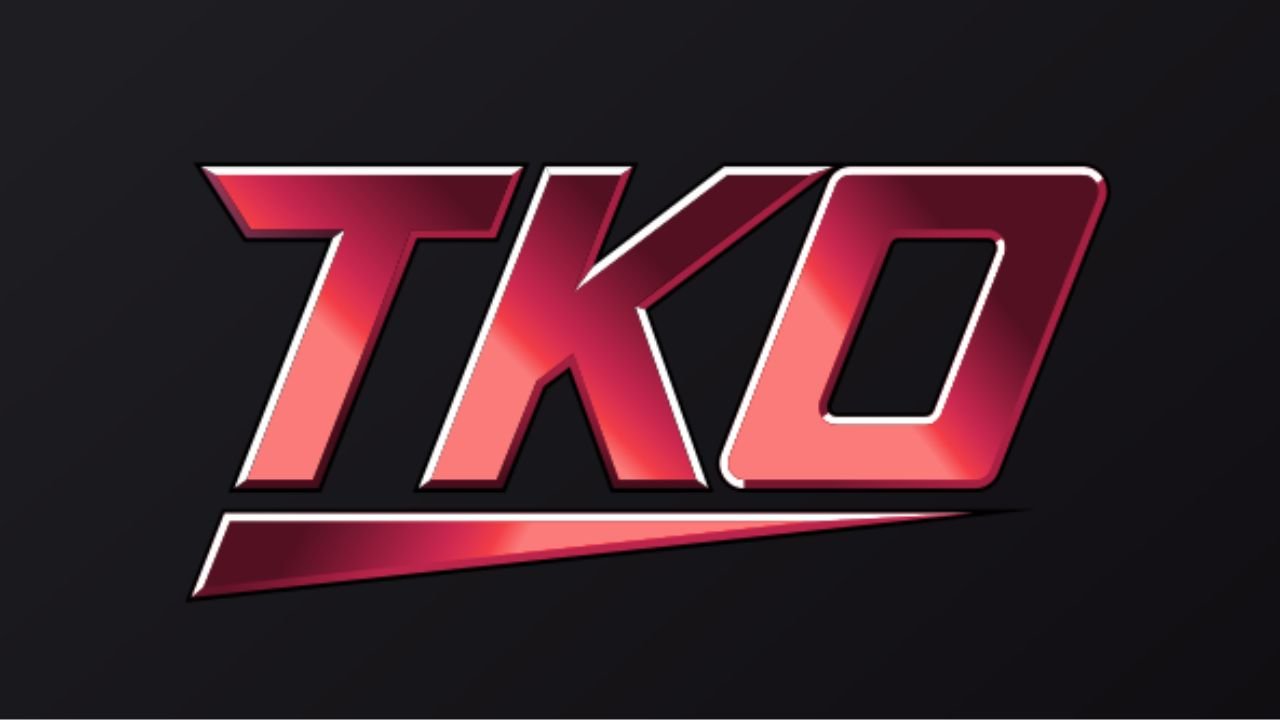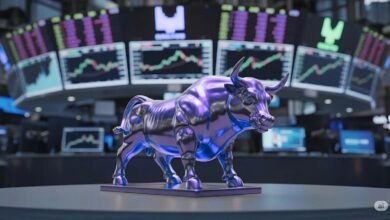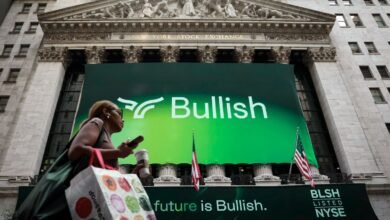The TKO Paradox: Knocked Down After a Knockout Quarter? A 10,000-Word Deep Dive
Dissecting the Bizarre 4.8% Stock Drop Despite Record-Breaking UFC & WWE Earnings. An In-Depth Analysis of the Numbers, the Psychology, and the Future of a Sports Entertainment Behemoth

The Unforeseen Knockdown
Imagine a championship fight. The bell rings to end the final round. One fighter stands tall in the center of the ring, having dominated every single moment of the bout. They were faster, stronger, and more strategic. The punch stats are overwhelmingly in their favor, the judges’ scorecards are a mere formality, and the roar of the crowd is deafening, chanting their name in unison. The victory is certain. It is an inevitability.
And then, the unthinkable happens. The referee raises the hand of the bruised, battered opponent. A wave of stunned silence washes over the arena, quickly replaced by a cacophony of confusion, disbelief, and frustration. The winner, by every objective measure, has somehow lost.
This is precisely the scene that played out in the financial markets for TKO Group Holdings Inc. (TKO). When the company, the undisputed titan born from the merger of UFC and WWE, announced its second-quarter 2025 earnings, the results were nothing short of a championship performance. They didn’t just meet expectations; they shattered them. Earnings per share (EPS) soared past forecasts. Revenue climbed a mountain of projections. The company was so confident that it raised its own performance goals for the rest of the year. It was a flawless victory on paper.
But the market, in its infinite and often inscrutable wisdom, played the role of the contrarian referee.
In the crucial after-hours trading session that followed the announcement, TKO’s stock, instead of soaring on the wings of triumph, was floored by a sudden jab. It staggered and fell 4.8%, closing at $155.61. The celebration was cancelled. The champagne was put back on ice. Wall Street’s sharpest minds were left scratching their heads, asking the same question that echoed through that imaginary arena: What just happened?
This story is far more than a dry recitation of financial data. It is a compelling drama about perception versus reality, about the intricate psychology that governs investor behavior, and about the invisible forces of expectation and fear that can overpower even the most triumphant of victories. It is the story of TKO, a company that won the fight but, for a moment, lost the favor of the crowd that matters most: the market.
In this comprehensive mega-analysis, we will peel back every layer of this fascinating paradox. We will not only explore what happened but strive to understand why it happened. We will conduct a thorough autopsy of TKO’s financial health, decode its ambitious game plan for the future, expose the subtle, long-term risks that may have spooked investors, and ultimately, attempt to decipher what this perplexing market reaction means for the future of this entertainment giant and for anyone considering investing in it. So, buckle up. The main event is not in the Octagon or the wrestling ring; it’s being fought right now on the charts and trading floors of the global market.
Chapter 1: A Victory Proclaimed – The Anatomy of a Stellar Quarter
Before we can understand the fall, we must first appreciate the staggering height of the victory. A company’s quarterly report is its report card, a public declaration of its performance. For TKO, the Q2 2025 report was filled with straight A’s, showcasing a business firing on all cylinders. Let’s break down these spectacular numbers into plain English.
1.1 Earnings Per Share (EPS): Surpassing the Target
What is EPS? Earnings Per Share is a fundamental measure of a company’s profitability. It’s calculated by dividing the company’s total profit by the number of its outstanding shares. In essence, it tells you how much money the company made for each share of its stock. It’s a key metric analysts and investors watch.
TKO’s Performance: Wall Street analysts, the seasoned experts who model these outcomes, had forecasted an EPS of
1.13forTKO.Thecompany,however,deliveredapowerful∗∗
1.17 per share**. This constitutes a “positive surprise” of 3.54%. While a four-cent beat might seem small in isolation, in the world of high-stakes finance, consistently beating consensus estimates is a sign of strong execution and a well-managed operation. It signals that the company is more efficient and profitable than even the optimists predicted.
1.2 Revenue: A Deluge of Dollars
What is Revenue? Often called the “top line,” revenue is the total amount of money a company generates from its sales of goods and services before any expenses are taken out. It’s a direct measure of the market’s demand for its products and its overall size and sales power.
TKO’s Performance: The market expected TKO to bring in a massive
1.22billion.Onceagain,TKOflexeditsmuscles,reportingacolossal∗∗
1.31 billion in revenue**. This wasn’t just a slight beat; it was a 7.38% surprise over the forecast. More impressively, this figure represented a 10% year-over-year (YoY) increase. This is a clear, unambiguous signal that the core products of TKO—the adrenaline-fueled fights of the UFC and the spectacular drama of WWE—are resonating with a growing global audience that is willing to pay for them.
1.3 Adjusted EBITDA: The True Engine of Profitability
What is Adjusted EBITDA? This may sound like complex financial jargon, but it’s arguably the most important number in this report. EBITDA stands for Earnings Before Interest, Taxes, Depreciation, and Amortization. It’s a measure of a company’s core operational profitability, stripping out the effects of accounting decisions and financing. The “Adjusted” part means one-time, non-recurring expenses are also removed, giving the purest possible view of the health of the underlying business.
TKO’s Performance: This is where TKO truly delivered the knockout blow. The company’s Adjusted EBITDA surged to $526 million. This wasn’t just a small increase; it was a jaw-dropping 75% surge compared to the same quarter last year. This figure is monumental. It demonstrates that not only is TKO making more money (higher revenue), but it’s also keeping a much larger chunk of that money as profit (higher efficiency).
The Margin Miracle: This operational excellence is perfectly reflected in the Adjusted EBITDA Margin, which skyrocketed from 25% last year to an incredible 40% this quarter. In simple terms, for every $100 the company made in revenue last year, it generated $25 in core profit. This year, it’s generating $40. This kind of margin expansion points to masterful cost control, lucrative new deals (like the one with Netflix), and powerful synergies from the UFC-WWE merger.
1.4 A Tale of Two Titans: Segment Performance
TKO’s strength is built upon two of the most powerful brands in entertainment history. Both pillars contributed mightily to this quarter’s success:
UFC (Ultimate Fighting Championship): The world’s premier mixed martial arts organization brought in $416 million in revenue. This growth was fueled by sold-out live events around the globe, strong pay-per-view (PPV) sales for marquee fights, and expanding international media rights.
WWE (World Wrestling Entertainment): The sports entertainment juggernaut performed even more strongly, generating a massive $556 million in revenue. Premium Live Events like WrestleMania, the initial financial impact of its landmark deal with Netflix, and robust merchandise sales propelled the brand to new heights.
In summary, TKO’s financial report was, by any objective standard, a masterpiece. The company was growing its sales, dramatically improving its profitability, and seeing both of its core businesses thrive. This brings us back to the central, burning question: if everything was so perfect, why did the stock plummet?
Chapter 2: The Market’s Cold Shoulder – Unraveling the Psychology of the Sell-Off
When a company reports a quarter this strong, the textbook reaction is a surge in its stock price. Investors, buoyed by the good news, should rush to buy shares, driving the price up. The fact that the opposite happened with TKO is a classic case study in market psychology, where emotion, expectation, and future-gazing often trump present-day facts. Here are the most likely culprits behind this paradoxical reaction.
2.1 The Cardinal Rule of Wall Street: “Buy the Rumor, Sell the News”
This is one of the oldest adages in investing, and it likely played a starring role here. The principle is simple: savvy investors don’t wait for good news to be officially announced. They act on the anticipation of it.
In the weeks and months leading up to TKO’s earnings report, institutional investors and sharp analysts likely saw the writing on the wall. They saw sold-out arenas, tracked strong viewership numbers, and understood the initial impact of new media deals. They began buying up shares, creating a “rumor-driven” rally that steadily pushed the stock price higher. By the time the official earnings were released, the spectacular results were already “priced in” to the stock. The good news was no longer news; it was a confirmation of what the market already suspected.
At this point, these early investors, having already made a handsome profit, saw the official announcement as their exit signal. They began to “sell the news” to lock in their gains. This wave of profit-taking created significant selling pressure, overwhelming any new buyers who were just reacting to the headline numbers. The result was a net decline in the stock price, leaving novice investors bewildered.
2.2 The Whisper Number: Was the Guidance “Good Enough”?
Investors are inherently forward-looking. While a great quarter is nice, what they truly care about is the next quarter, and the quarter after that. This is why a company’s “guidance” (its forecast for future performance) is often more important than its past results.
TKO did, in fact, raise its full-year guidance. It projected revenue between $4.63 billion and $4.69 billion and adjusted EBITDA between $1.54 billion and $1.56 billion. On the surface, this is positive. But the market often operates on a “whisper number”—an unofficial, unwritten set of expectations that can be even more aggressive than the official analyst forecasts.
It’s entirely possible that the market’s whisper number for TKO’s guidance was even higher. Perhaps some ultra-bullish investors were hoping for a more dramatic upward revision, fueled by the massive 75% EBITDA growth. When the company’s official guidance, while strong, didn’t meet these stratospheric (and perhaps unrealistic) expectations, it was interpreted as a sign of potential slowing growth ahead. This “disappointment,” however irrational, could have triggered a sell-off.
2.3 The Valuation Tightrope: A High P/E Ratio
The provided data reveals a crucial detail: TKO’s P/E (Price-to-Earnings) ratio is a lofty 73.96.
What is a P/E Ratio? It’s a valuation metric that compares a company’s stock price to its earnings per share. A high P/E ratio suggests that investors are willing to pay a premium for the stock because they expect very high growth in the future.
The Peril of High Valuations: A P/E of nearly 74 is very high. It means the stock is priced for perfection. When expectations are this high, there is no room for error. Even spectacular results, like the ones TKO posted, might not be enough to justify such a rich valuation in the eyes of some investors. They may see the good news as an opportunity to de-risk and sell a “pricey” stock before any potential future hiccups can cause a much larger crash. It’s a classic case of a stock being a “victim of its own success.”
2.4 The Macroeconomic Shadow: Storm Clouds on the Horizon
No company exists in a vacuum. It operates within the larger global economy. The market’s reaction to TKO’s earnings could have been influenced by broader anxieties that had nothing to do with TKO itself. These could include:
Interest Rate Fears: Concerns that a central bank might raise interest rates to combat inflation can spook markets. Higher rates make borrowing more expensive for companies and can make safer investments like bonds more attractive than stocks.
Inflation Data: A higher-than-expected inflation report can trigger fears of a slowing economy.
Geopolitical Tensions: Global conflicts or political instability can lead to a general “risk-off” sentiment, where investors sell stocks and move to cash or gold.
On a day when the broader market is nervous, even a stellar earnings report can be overlooked as investors flee to safety. TKO’s stock may have simply been caught in a wider market downdraft.
2.5 A Sudden Spotlight on Long-Term Risks
An earnings call is a moment of high visibility. While the numbers are celebrated, it’s also a time when the company’s executives are grilled by analysts about future challenges. The positive report may have paradoxically prompted investors to look past the current quarter and focus more intensely on the long-term risks outlined in the report: the upcoming UFC media rights renewal, the regulatory maze of the new boxing initiative, and the threat of market saturation. We will explore these risks in detail in a later chapter, but the mere mention of them during a period of peak attention could have been enough to give some investors cold feet.
In conclusion, the 4.8% drop was not a judgment on TKO’s excellent quarter. It was a complex cocktail of profit-taking, sky-high expectations, valuation concerns, and a market perhaps more focused on the potential storms of tomorrow than the sunshine of today.
Chapter 3: The View from the Inside – A Financial Health Autopsy
To truly understand a company, we must look beyond the headline numbers and the market’s emotional reactions. We need to perform a financial autopsy, examining the underlying health and structure of the business. Using the data points from sources like InvestingPro, we can get a much clearer picture of TKO’s fundamental strength.
3.1 The Financial Health Score: A Clean Bill of Health
InvestingPro awarded TKO a Financial Health Score of 2.61, rated as “GOOD.” This is a significant seal of approval. This comprehensive score is not a simple metric; it’s the result of an algorithm that analyzes over 100 different factors across profitability, growth, cash flow, and momentum. A “GOOD” rating indicates that the company’s financial foundation is solid. It has strong cash flow to cover its obligations, it is effectively turning revenue into profit, and it is on a sustainable growth trajectory. This score suggests that TKO is well-capitalized and resilient enough to withstand potential economic downturns.
3.2 The Piotroski Score: The Mark of a Financial Fortress
This is a metric that serious, fundamental investors love. Developed by Stanford accounting professor Joseph Piotroski, the Piotroski Score is a nine-point scale that acts as a financial strength detector for a company. It uses nine criteria related to profitability, leverage, liquidity, and operating efficiency to separate financially strong companies from weak ones.
TKO boasts a Piotroski Score of 7. This is an excellent score. A score of 7, 8, or 9 is considered very strong, indicating a company with a very healthy financial position. It suggests that TKO is improving its profitability, not taking on excessive debt, and running its core operations more and more efficiently. For a long-term investor, this score is a powerful signal that the company’s management is making smart decisions and that the business itself is fundamentally sound, irrespective of short-term stock price fluctuations.
3.3 The Valuation Conundrum: Expensive Price Tag, But Undervalued?
Herein lies one of the most interesting contradictions for TKO. As we discussed, the P/E ratio of 73.96 makes the stock appear “expensive” on a traditional basis. This high multiple suggests the market has priced in years of future growth.
However, the InvestingPro analysis also notes that the stock appears to be trading below its “Fair Value.” How can a stock be both expensive (high P/E) and undervalued (below Fair Value) at the same time?
P/E is a snapshot: The P/E ratio is based on past or current earnings. It doesn’t inherently account for the rate of future growth.
Fair Value is a forward look: Fair Value models (like a Discounted Cash Flow or DCF analysis) attempt to calculate the present value of a company’s entire future stream of cash flows.
This suggests that while TKO’s stock price is high relative to its current earnings, its potential for massive future cash flow growth (from the Netflix deal, new UFC rights, international expansion, etc.) is so significant that even at its current price, it could still be considered a bargain for a long-term holder. This is the classic growth-stock dilemma: you have to pay a premium today for the promise of massive profits tomorrow.
3.4 Technical Indicators: A Buying Signal in the Noise?
Technical analysis looks at chart patterns and trading statistics to predict future price movements. The report notes that technical indicators suggest the stock is in “oversold territory.”
What does “Oversold” mean? In technical terms, this means that a stock has been sold off too heavily and too quickly. The selling momentum is seen as unsustainable, and the stock is due for a “reversion to the mean” or a bounce-back. Indicators like the Relative Strength Index (RSI) falling below a certain level (typically 30) often trigger this classification.
Implications for TKO: The sharp 4.8% drop likely pushed these indicators into oversold territory. For traders and some investors, this is a technical buy signal. It suggests that the recent selling pressure may be exhausted and that buyers could soon step in, presenting an attractive entry point for those willing to bet on a rebound.
In summary, the internal financial examination reveals a company with a rock-solid foundation (Good Health Score, high Piotroski Score) but a premium price tag (high P/E). However, forward-looking models and technical indicators suggest that the recent dip might represent a compelling opportunity for those who believe in the company’s long-term growth story.
Chapter 4: The Arena of Tomorrow – TKO’s Vision and Strategic Gambits
A true champion never rests on their laurels. They are always training for the next fight. TKO’s management is looking far beyond this stellar quarter, executing an ambitious, multi-pronged strategy designed to secure its dominance for the next decade.
4.1 The Netflix Masterstroke: Ascending to the Top Tier of Global Media
Mark Shapiro, TKO’s President and COO, made a statement that encapsulates the company’s new status: “We are now a top tier property for the Netflix platform.”
This is not hyperbole; it is a statement of fact with profound implications. The landmark deal, which will bring WWE’s flagship show, Monday Night Raw, exclusively to Netflix globally starting in 2025, is a paradigm-shifting move.
Unprecedented Global Reach: Netflix has over 270 million paid subscribers in more than 190 countries. This deal gives WWE instantaneous, direct-to-consumer access to a colossal global audience, bypassing the complexities of negotiating separate cable and broadcast deals in each country. From Mumbai to Mexico City, a new generation of fans will be created.
Tapping the Fountain of Youth: Younger audiences, the lifeblood of any entertainment brand, are “cord-cutters” and “cord-nevers.” They live on streaming platforms. This partnership ensures that WWE remains relevant and accessible to the demographic that matters most for long-term growth.
Financial Fortification: This is a multi-billion dollar, long-term deal. It provides TKO with a predictable, massive, and stable revenue stream for years to come. This financial certainty de-risks the business significantly and gives management the capital and confidence to invest in other growth areas.
4.2 The Delicate Balancing Act: Maximizing Monetization and Reach
Shapiro also articulated the company’s core strategic philosophy: “Our mission remains finding a balance between maximizing monetization and reach.”
This is the central challenge for every modern media company.
Monetization: This is the strategy of extracting the maximum possible revenue from your most dedicated fans. The UFC’s model with ESPN+, which requires a subscription plus an additional PPV fee (often
70
−
70−
80) for major events, is a prime example of high monetization.
Reach: This is the strategy of getting your content in front of the largest possible audience to build brand awareness and create new fans, even if it means lower revenue per viewer initially. The WWE’s move to the base tier of Netflix is a pure reach play.
TKO is brilliantly playing both sides. It’s using the high-monetization UFC model for its established, hardcore fanbase while leveraging the massive-reach Netflix model to funnel a new generation of global fans into the WWE ecosystem. It’s a sophisticated strategy that allows them to have their cake and eat it too.
4.3 The Next Big Gamble: Entering the Squared Circle of Boxing
TKO is not content to simply dominate its existing territories. It’s planning an audacious invasion of a new one: a boxing initiative set to launch in early 2026.
This is a bold, high-risk, high-reward gambit. The world of professional boxing has long been criticized for being fragmented, confusing, and mismanaged, with a dizzying array of promoters, sanctioning bodies, and champions. This chaos, however, presents a massive opportunity.
If any company has the operational expertise, marketing muscle, and event production prowess to bring order to the chaos of boxing, it’s TKO. By applying the lessons learned from building the UFC into a global powerhouse, TKO could potentially unify, streamline, and revitalize the sport, creating a product that is far more compelling for fans and broadcasters. Success here would open up an entirely new, multi-billion dollar revenue stream.
4.4 The Analyst Consensus: A 21% Upside Potential
Despite the market’s one-day pessimism, the experts who study TKO for a living remain overwhelmingly bullish. The consensus median price target from analysts suggests a potential upside of 21% from its current levels. This indicates that, in their detailed models, Wall Street professionals believe the company’s long-term growth trajectory (powered by Netflix, the UFC’s strength, and future initiatives) far outweighs the short-term market jitters. They see the recent dip not as a red flag, but as a discount.
Chapter 5: The Gauntlet of Challenges – Headwinds on the Horizon
No epic journey is without its trials. While TKO’s future looks bright, its path is lined with significant obstacles and challenges that could derail its progress. A prudent investor must understand these risks as clearly as they understand the opportunities.
5.1 The Billion-Dollar Question: The UFC Media Rights Renewal
This is, without a doubt, the most significant and immediate risk facing TKO. The UFC’s current domestic media rights deal with ESPN is set to expire. While the WWE’s Netflix deal set an incredibly high bar and demonstrated TKO’s negotiating power, it also created immense pressure.
The Expectation Game: The market now expects the UFC to secure a new deal with a similar or even greater uplift in value. Anything less could be perceived as a major failure and would severely damage revenue forecasts and investor confidence.
The Competitive Landscape: While tech giants like Amazon, Apple, and Google are entering the live sports arena, creating a competitive bidding environment, there’s no guarantee they will pay the price TKO wants. The landscape of sports media is in flux, creating both opportunity and uncertainty. A failure to secure a blockbuster deal is the biggest “bear case” for the stock.
5.2 The Thorny Crown of Boxing
Entering the world of boxing is like stepping into a minefield.
Regulatory Nightmare: Unlike the UFC, which largely regulates itself, boxing in the U.S. is overseen by a patchwork of state athletic commissions, each with its own rules, regulations, and political interests. Navigating this labyrinth will be a monumental legal and logistical challenge.
Entrenched Competition: The sport is dominated by powerful and established promoters like Al Haymon’s PBC and Eddie Hearn’s Matchroom. They have deep relationships with fighters and networks and will not cede territory without a fight.
Fighter Power: Top boxers, unlike UFC fighters, are often independent contractors with immense leverage. Uniting them under a single promotional banner and getting them to fight each other consistently—the key to a successful league—is a challenge that has plagued the sport for decades.
5.3 The Saturated Sea of Premium Entertainment
We live in the “attention economy,” and the competition is fierce. TKO is not just competing with other sports; it’s competing with Netflix, Disney+, YouTube, TikTok, video games, and every other form of entertainment imaginable for a consumer’s limited time and money.
Subscription Fatigue: Are consumers willing to add another subscription or pay for another PPV in a world where they are already juggling multiple monthly entertainment bills?
The Spectacle Ceiling: Is there a limit to how many premium live events the market can support? The risk of market saturation is real, and it could cap TKO’s long-term growth potential.
5.4 The Macroeconomic Shadow
TKO’s business is highly cyclical and dependent on discretionary consumer spending. Ticket sales, merchandise, and PPV buys are luxuries, not necessities.
Recessionary Risk: In the event of a significant economic downturn or recession, households will tighten their belts. Entertainment spending is often one of the first things to be cut. This would directly impact TKO’s top-line revenue and could force them to lower ticket prices or see event attendance decline.
Final Chapter: The Investor’s Corner – Opportunity or Warning Bell?
We return to where we started, standing over the fallen stock, trying to make sense of the scene. For an investor, every price movement is a question: Is this a danger to be avoided or an opportunity to be seized?
(Once again, this is a purely analytical summary and not financial advice.)
To make an informed decision, one must weigh the arguments from both the bulls (those who are optimistic) and the bears (those who are pessimistic).
The Bull Case (Reasons to Be Optimistic):
Impeccable Fundamentals: The company is a cash-generating machine. The 75% YoY growth in adjusted EBITDA is a sign of supreme operational efficiency and pricing power. The Piotroski Score of 7 confirms a fortress-like balance sheet.
A Clear and Powerful Growth Engine: The WWE-Netflix deal is a transformative catalyst that guarantees global growth and a stable, massive revenue stream for the next decade.
Untapped Potential: The boxing initiative, while risky, represents a colossal blue-sky opportunity. Success here could fundamentally revalue the entire company upwards.
Valuation Opportunity: The stock’s recent drop, combined with its “oversold” technical status and “Fair Value” assessment, presents a classic “buy the dip” scenario for those with a long-term horizon.
Expert Endorsement: The consensus of Wall Street analysts points towards significant upside, suggesting the professional community believes the market’s recent reaction was an overreaction.
The Bear Case (Reasons to Be Cautious):
Nosebleed Valuation: A P/E ratio of nearly 74 is extremely high. The stock is priced for perfection, making it highly vulnerable to any future disappointment. A small misstep could lead to a large correction.
The UFC Rights Cliffhanger: The upcoming UFC media rights renewal is the single biggest risk on the horizon. An underwhelming deal would be a massive blow to the investment thesis and could send the stock tumbling.
Execution Risk: The boxing initiative is fraught with competitive and regulatory peril. A costly failure here could drain resources and distract management.
Economic Sensitivity: The business is vulnerable to a recession. A downturn in consumer spending would directly and negatively impact TKO’s core revenue streams.
Negative Market Sentiment: The fact that the market punished a stellar report shows that investor sentiment is fragile. The stock could remain under pressure until there is more clarity on future catalysts.
Conclusion: The Final Bell
The story of TKO’s Q2 2025 earnings is a perfect microcosm of the modern stock market: a battleground where hard numbers collide with human emotions, and where the triumphs of today are constantly measured against the anxieties of tomorrow.
TKO Group Holdings won the quarter in a spectacular fashion. They proved that their combined entity is a financial powerhouse with unparalleled brands and exceptional management. Yet, the market, weighed down by high expectations and focused on future hurdles, delivered a surprising knockdown.
For an investor, the final decision rests on their time horizon and risk tolerance.
A short-term trader might see the “oversold” signal and play for a quick bounce. A risk-averse, value-oriented investor might look at the high P/E ratio and the looming UFC rights negotiation and decide to wait on the sidelines for a better entry point or more certainty.
But for a long-term, growth-oriented investor—someone who believes in the enduring power of premium live content, who sees the transformative potential of the Netflix partnership, and who trusts in the management team that built these two empires—this 4.8% drop might look less like a knockdown and more like a fighter taking a brief, strategic knee. It’s a moment to catch a breath before rising again, stronger and more determined, to win the championship rounds that truly matter. The final bell has not yet rung.
(Disclaimer: This article is for informational and educational purposes only. It does not constitute financial advice or a recommendation to buy or sell any securities. Please consult with a qualified financial advisor before making any investment decisions.)





